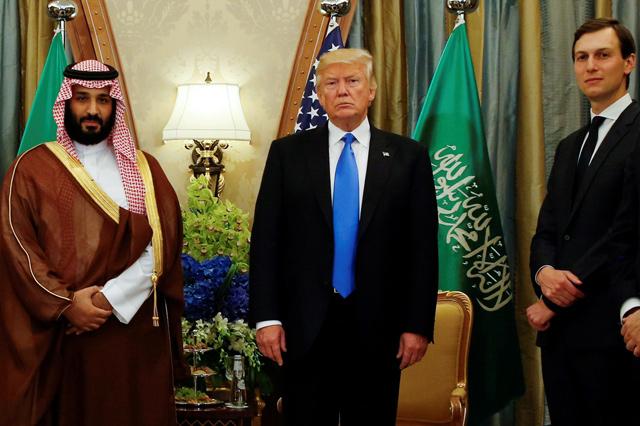You are here
‘US peace plan aims to raise $50b, create million Palestinian jobs’
By AFP - Jun 23,2019 - Last updated at Jun 23,2019

A Palestinian protester rolls a tyre during a demonstration against the US-led Palestinian-Israeli peace conference in Bahrain, in the village of Kfar Qaddum, near Nablus in the occupied West Bank, on Friday (AFP photo)
WASHINGTON — The United States said Saturday that its Middle East peace plan to be presented this week in Bahrain aims to raise more than $50 billion for the Palestinians and create one million jobs for them within a decade.
Unveiling details for the first time of its long-awaited peace initiative, President Donald Trump's administration said it was looking to attract major international investment to the Palestinians and to dramatically improve infrastructure and internal governance in the West Bank and Gaza Strip.
The conference Tuesday and Wednesday in Bahrain, led by Trump's son-in-law and adviser Jared Kushner, is the opening of the US government's delayed peace effort, which officials say will later include a political component.
But the Palestinian Authority is boycotting the so-called Peace to Prosperity workshop, charging that the unabashedly pro-Israel Trump is seeking to buy off the Palestinians and deprive them of an independent state.
The White House cast the plan — to be discussed in more detail in Bahrain with finance chiefs of oil-rich Gulf Arab states — as historic.
“Peace to Prosperity represents the most ambitious and comprehensive international effort for the Palestinian people to date,” the plan released by the White House said.
“It has the ability to fundamentally transform the West Bank and Gaza and to open a new chapter in Palestinian history — one defined, not by adversity and loss, but by freedom and dignity,” it said.
It said that the plan aimed to raise more than $50 billion over the next decade, with a goal of more than doubling Palestinian gross domestic product.
The White House said the initiative had the power to transform the troubled Palestinian economy by creating more than one million jobs — bringing the unemployment rate down to the single digits, in line with developed economies — and reducing the poverty rate by 50 per cent.
In a step likely to outrage Palestinian leaders, it said that money would be administered by a multinational development bank as a way to ensure better governance and prevent corruption.
Political plan to come
After spending more than two years working on the plan, Trump’s son-in-law and senior aide Jared Kushner offered a framework full of specifics — even lauding the ice cream of Ramallah in a section on promoting tourism.
But it remains unclear who will pay the bill for the Peace to Prosperity plan and whether Gulf Arabs will be willing to contribute even before a political settlement.
Jason Greenblatt, a senior aide to Trump who crafted the peace plan alongside Kushner, said that the political component may come as late as November.
The plan had already been held up due to Israel’s elections in April, but the country is going to the polls again after Prime Minister Benjamin Netanyahu failed to form a coalition.
The Palestinian leadership is deeply distrustful of Kushner, a family friend of Netanyahu, and Trump, who has taken a series of landmark steps to support Israel including recognising Jerusalem as its capital.
US officials have hinted that the eventual peace plan will not mention the creation of an independent Palestinian state, a goal of decades of often intense US diplomacy.
“Our presence in Manama would only be used to legitimise the US initiative that aims at depriving us of our rights, changing the historical formula of ‘land for peace’ to ‘peace to prosperity’,” said a Palestinian statement released before the White House announced details.
Hamas, which controls the Gaza Strip, has also sharply rejected the Bahrain conference, with the group’s leader Ismail Haniyeh saying the workshop aimed to transform “the Palestinian cause from a political cause to an economic cause”.
The economic plan, without any direct mention of Hamas, nonetheless said it also aimed to assist the Gaza Strip.
Projects include a $590 million upgrade of Gaza’s main power plant, which the White House said would create tens of thousands of jobs and provide reliable energy for the first time in years to the crowded and impoverished territory.
Related Articles
DOHA — Qatar said on Friday that economic development needed for Israeli-Palestinian peace could not be achieved without "fair political sol
CAIRO — The Arab League Sunday reaffirmed a pledge to pay $100 million a month to the Palestinian Authority, a day after Washington unveiled
RIYADH — White House Adviser Jared Kushner held talks with Saudi Arabia's king and crown prince during a regional tour to rally support for












